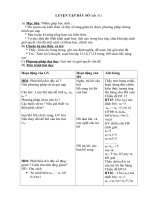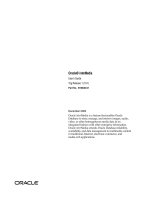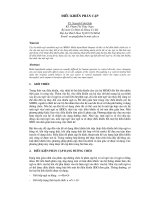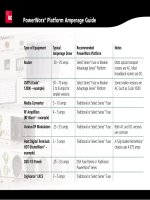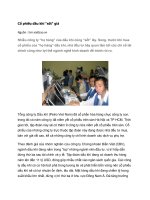Tài liệu Learning Circle Facilitators Guide pptx
Bạn đang xem bản rút gọn của tài liệu. Xem và tải ngay bản đầy đủ của tài liệu tại đây (338.82 KB, 39 trang )
APPENDIX 7 INDICATIVE SCHEDULES
Live & Learn Environmental Education Page 1
2 Denison Road, Suva, Fiji Islands
Tel: +679 331 5868 Fax: +679 330 5868 Email:
T6123-REG
Promoting Effective Water Management
Policies and Practices (Phase 3)
Pilot Demonstration Activity
of Developing and Testing
Environmental Education and Awareness
Methodologies and Tools
Learning Circle
Facilitators’ Guide to Promote
Sustainable Development in the Tonle
Sap
Tonle Sap – Cambodia
October 2004
Prepared for the Asian Development Bank
A Live & Learn Environmental Education Publication
Disclaimer: This report was prepared by consultants for the Asian Development Bank. The findings,
interpretations, and conclusions expressed in it do not necessarily represent the views of the Asian
Development Bank (ADB) or those of its member governments. ADB does not guarantee the accuracy of
the data included in this report and accepts no responsibility for any consequences of their use.
T6123-REG: Promoting Effective Water Management Policies and Practices (Phase 3) Pilot Demonstration Activity for Developing and
Testing Environmental Education and Awareness Methodologies and Tools
Learning Circles Facilitators’ Guide to Promote Sustainable Development in the Tonle Sap
Live & Learn Environmental Education Page 1
2 Denison Road, Suva, Fiji Islands
Tel: +679 331 5868 Fax: +679 330 5868 Email:
TABLE OF CONTENTS
I. INTRODUCTION ....................................................................................................2
II. THE ROLE OF A LEARNING CIRCLE FACILITATOR.................................3
III. PRACTICAL ARRANGEMENTS.........................................................................4
Contact details ............................................................................................................4
Taking notes................................................................................................................4
Organising visiting speakers.......................................................................................4
Evaluation...................................................................................................................5
IV. THE FIRST MEETING...........................................................................................6
1. Getting to know each other.....................................................................................6
2. Setting some ground rules ......................................................................................8
3. Agreeing on some objectives..................................................................................9
4. Developing ‘road maps’ .......................................................................................10
5. Agreeing on themes/topics/priorities....................................................................11
6. Practical arrangements..........................................................................................11
7. What can we do?...................................................................................................11
8. Wind-up................................................................................................................13
V. FACILITATOR RESOURCE #1: WHAT DOES YOUR ROLE INVOLVE? 14
VI. FACILITATOR RESOURCE #2: SUGGESTIONS FOR KEEPING THINGS
ON TRACK.............................................................................................................15
VII. FACILITATOR RESOURCE #3: TIPS FOR DEALING WITH CONFLICT
AND EMOTION.....................................................................................................17
VIII. FACILITATOR RESOURCE #4: ENCOURAGING PARTICIPATION,
DEALING WITH DOMINANT PEOPLE...........................................................21
IX. FACILITATOR RESOURCE #5: USING QUESTIONS EFFECTIVELY.....23
X. GETTING ORGANISED #1: LEARNING CIRCLE REGISTRATION FORM
..................................................................................................................................25
XI. GETTING ORGANISED #2: PARTICIPANT EVALUATION FORM..........26
XII. GETTING ORGANISED #3: FACILITATOR’S EVALUATION FORM......28
XIII. GETTING ORGANISED #4: FACILITATOR EVALUATION FOR STUDY
CIRCLE PARTICIPANTS....................................................................................30
XIV. LEARNING CIRCLE RESOURCE SHEET #1: AN INTRODUCTION TO
LEARNING CIRCLES..........................................................................................31
XV. LEARNING CIRCLE RESOURCE SHEET #2: HOW ADULTS LEARN.....33
XVI. LEARNING CIRCLE RESOURCE SHEET #3: DIALOGUE VERSUS
DEBATE.................................................................................................................. 37
T6123-REG: Promoting Effective Water Management Policies and Practices (Phase 3) Pilot Demonstration Activity for Developing and
Testing Environmental Education and Awareness Methodologies and Tools
Learning Circles Facilitators’ Guide to Promote Sustainable Development in the Tonle Sap
Live & Learn Environmental Education Page 2
2 Denison Road, Suva, Fiji Islands
Tel: +679 331 5868 Fax: +679 330 5868 Email:
I. INTRODUCTION
This guide provides general background material and suggestions to support you in your
role as facilitator. A series of Facilitator Resources provide specific guidance related to
your role, covering topics such as
•
Effective facilitation – what is it and how you can do it
•
Dealing with conflict, dominating people and encouraging to participation
The Learning Circle Resources provide more general background information about
learning circles and how adults learn. These might be useful in thinking about how you
want to facilitate and in introducing participants to the learning circle. The material might
also be of interest to participants.
•
What is a learning circle? – what does it look like, how does it work, history,
its strengths as an approach to learning, problem solving and action
•
How adults learn
The Getting Organised series contains handouts to assist you with administration,
monitoring and evaluation.
This guide also provides specific guidance on running the first meeting of the learning
circle, which is the time when a group gets to know each other and decides its direction,
priorities and how it will work together. There is a companion participant guide to the first
meeting called Getting Started.
This Facilitator Guide has been designed as a general resource that can be used with any
learning circle. Additional guides are planned to assist you to facilitate the specific subjects
you will be exploring in this learning circle – ie the work of the group after its first meeting.
The material in this guide is a resource for you. Read it through. Use it in whatever way
you think will work for you and your group. If you think that some examples need more
explanation, then provide this. If you think some material should be dropped, that’s fine
too. Go through those parts that you think are most useful a few times. Decide what parts
you want to explore with participants. You may want to use some of the background
material as a basis for introducing participants to the idea of learning circles or discussing
how adults learn.
Issues and challenges facing your community may not be the same as those in another area.
So each module provides opportunities for participants to adapt the material to their local
situation. Encourage participants (you included) to keep their own media file of newspaper
and magazine articles on issues that interest them - so your group can see how the issues
you are exploring are dealt with and discussed in your area.
The main role of a learning circle facilitator is organisational; actual facilitation plays a
secondary role. In many learning circles, people take turns to facilitate the leaning circle
meetings, once they see how the trained facilitator has facilitated. This is a valuable way of
encouraging involvement, de-mystifying the role of facilitator and extending the range of
skills people can build through their participation in the learning circle.
T6123-REG: Promoting Effective Water Management Policies and Practices (Phase 3) Pilot Demonstration Activity for Developing and
Testing Environmental Education and Awareness Methodologies and Tools
Learning Circles Facilitators’ Guide to Promote Sustainable Development in the Tonle Sap
Live & Learn Environmental Education Page 3
2 Denison Road, Suva, Fiji Islands
Tel: +679 331 5868 Fax: +679 330 5868 Email:
II. THE ROLE OF A LEARNING CIRCLE
FACILITATOR
As a facilitator of a learning circle, your main role is to help the group clarify what it wants
to focus on and then help keep discussion productive. You are not expected to be an
'expert' or know more than others in the learning circle. An important part of the
philosophy of a learning circle is that everyone learns from each other and everyone has
something to contribute. If you do have expertise in some of the topics you are covering,
be careful not to be drawn into the role of ’teacher’.
Your most important task is being organised and familiar enough with the issues to help
discussion to flow. Going through the material beforehand and thinking a little about it will
help you be effective.
Your job also includes coordinating (but not necessarily doing) the practical organisation
— making sure the group has what it needs for the session (e.g. photocopies of relevant
resource material, butcher’s paper and pens).
As a facilitator, you can also play an important role in helping the group work well
together, setting a positive tone, letting others have their say before expressing your own
opinions, and reminding the group of the ‘ground rules’ they have agreed to use in their
dealings with one another.
The group may decide to share the role of the facilitator so those participants who want to
can have a chance to develop their skills in this area. If so, people need to read this guide
before they start to facilitate.
T6123-REG: Promoting Effective Water Management Policies and Practices (Phase 3) Pilot Demonstration Activity for Developing and
Testing Environmental Education and Awareness Methodologies and Tools
Learning Circles Facilitators’ Guide to Promote Sustainable Development in the Tonle Sap
Live & Learn Environmental Education Page 4
2 Denison Road, Suva, Fiji Islands
Tel: +679 331 5868 Fax: +679 330 5868 Email:
III. PRACTICAL ARRANGEMENTS
There are a few practical things that will help the learning circle work well and provide the
opportunity for the group to contribute to broader community discussion.
Contact details
The registration form included with this guide is designed to record some details for each
participant (name, address, other contact details like phone or email.). This information
enables members of the group to contact each other between meetings — for example, if a
meeting time needs to be changed or someone wants to organise an extra activity.
The registration form allows people to choose not to make their contact details available to
other learning circle members. It also allows them to indicate if they are willing for their
details to be provided to other learning circle groups, to enable networking and sharing of
information.
Taking notes
Recording the work of the learning circle can help people to focus. It makes it possible for
the group to see how its views have developed and to share experiences with other groups.
Written notes also make it easier to include any initiatives or activities undertaken by the
group in a newsletter or on a website, so learning circles can learn from one another and
participants see a visible outcome from their activities. Keeping notes also shows that the
knowledge and experiences of members is valued.
Talk to the group about how they want to organise note taking. It doesn't need to be a big
job. Notes could cover such things as:
•
what the group covered/discussed
•
key issues/ideas
•
points of particular controversy
•
issues where participants agreed to disagree
•
agreed action outcomes, activities, eg. visiting speakers, videos watched by
the group etc.
If the group thinks it is a good idea, then decide whether one person will take on the job or
it will be shared around. At the end of the learning circle, the group might want to consider
sending the notes to a local library or other community resource centre so they provide a
resource for other community groups or researchers.
Organising visiting speakers
Hearing direct from people who are actively involved in an issue can be a good way to find
out about a subject quickly. If the group wants to invite a speaker — say a local community
representative, a local politician, an expert in crime prevention — be sensitive to the
commitment this involves. Ask the group to think about how it might recognise that the
speaker has contributed their time - eg provide a meal. You might also think about joining
with another learning circle group in your area when planning a guest speaker, to reduce the
demand on a speaker's time.
T6123-REG: Promoting Effective Water Management Policies and Practices (Phase 3) Pilot Demonstration Activity for Developing and
Testing Environmental Education and Awareness Methodologies and Tools
Learning Circles Facilitators’ Guide to Promote Sustainable Development in the Tonle Sap
Live & Learn Environmental Education Page 5
2 Denison Road, Suva, Fiji Islands
Tel: +679 331 5868 Fax: +679 330 5868 Email:
If the group has identified someone they would like to speak to the group, and that person
has agreed to come, it is a good idea for you to make contact before the meeting to see if
the speaker needs transport to and from the meeting. You can also give the speaker an idea
of the range of people in your group before the meeting, so they can prepare appropriately.
Evaluation
Make time during the group's final meeting to fill in the evaluation sheets included with this
Facilitator Guide (see Getting Organised #2, 3 & 4).
Evaluation is an important part of the learning circle process. It provides an opportunity for
participants to reflect on their work and their learning. Organisers get feedback about what
worked well and any changes that need to be made to the resource materials or how the
learning circles are conducted and supported.
T6123-REG: Promoting Effective Water Management Policies and Practices (Phase 3) Pilot Demonstration Activity for Developing and
Testing Environmental Education and Awareness Methodologies and Tools
Learning Circles Facilitators’ Guide to Promote Sustainable Development in the Tonle Sap
Live & Learn Environmental Education Page 6
2 Denison Road, Suva, Fiji Islands
Tel: +679 331 5868 Fax: +679 330 5868 Email:
IV. THE FIRST MEETING
Your role and input at the first meeting is perhaps the most important part of your job as
facilitator. The following section provides some suggestions on how you might run this
session.
A key aim of the first meeting of a learning circle is for people to get to know one another
and for you (the facilitator) to explore participants’ main interests, why they have joined the
group and what they want to achieve. Participants then need to plan and agree on their
objectives and how they will work together.
Getting Started is a companion guide to the first meeting for participants. The following
section is designed to help you work with the participant guide.
1. Getting to know each other
Facilitators might consider bringing some food and drink to the first meeting, or organising
for participants to each bring a plate to share. If not all members of the group know each
other, mixing informally over refreshments can be a good way to get things started. Name
tags can be useful too. If you don’t know everyone, introduce yourself and talk informally
with others about issues they are interested in. Your objective is to welcome everyone and
create a friendly and relaxed atmosphere.
Once everyone has arrived, introduce yourself and the learning circle. You need to decide
how much time you want to spend giving an overview of the general principles of a
learning circle, and the objectives of this specific learning circle program. The resource
sheets give you some background material to draw on. You might decide to be very brief
and provide some handouts for people to read at their leisure, or lead people in a discussion
of learning circles as an approach to adult learning.
Then participants need to get to know one another.
Activity: Who are we?
Ask people to pair up with the person sitting next to them. One participant asks questions of
the other before switching roles. Find out something about the person, their background,
what they do, any special interests and why they have joined the learning circle. After five
minutes or so, each member of the group should introduce their pair to the larger group.
Alternatively, you might begin with each person telling a story that conveys some things
they think are important about who they are and what they believe.
It might be helpful for someone to take brief notes as each person talks. Allow time for
follow-up questions to each other.
T6123-REG: Promoting Effective Water Management Policies and Practices (Phase 3) Pilot Demonstration Activity for Developing and
Testing Environmental Education and Awareness Methodologies and Tools
Learning Circles Facilitators’ Guide to Promote Sustainable Development in the Tonle Sap
Live & Learn Environmental Education Page 7
2 Denison Road, Suva, Fiji Islands
Tel: +679 331 5868 Fax: +679 330 5868 Email:
Activity: Active listening
Explain that an important principle in discussion circles is respect for other participants and
one aspect of this is being an active listener. Many people believe they are good listeners
but listening is a skill that needs to be practiced and refined. People who participate in the
follow exercise are often pleasantly surprised to have the experience of really being listened
to for an extended period of time.
Choose an issue that you think most people in the group will be able to talk about. Write a
few questions on butchers paper that help people connect with the issue, such as:
•
Why are you concerned about this issue?
•
How would you describe the issue?
•
How have your experiences effected your opinions about this issue?
•
What effect do other people’s opinions have on your views?
Ask everyone to reserve discussion about the exercise itself until it is completed.
Ask people to pair with someone they do not know well. One person will talk for three
minutes without interruption in response to the questions you have written while the other
listens. After three minutes the partners reverse roles.
Explain that the task for each listener is to give full attention to the person talking and to
say as little as possible. The listeners speak only to ask questions in order to understand
better what is being said, not to give advice or express opinions. The listeners should
demonstrate active listening through body language (nodding head in agreement, facial
expressions etc.) or short phrases (“I see”, “Yes, I understand” etc)
When each pair is finished, go through the following questions.
A question for all
•
What are your main reactions to this exercise? In what ways was your
experience of this listening exercise different from the first exercise where you
had to introduce your pair?
Questions for speakers
•
What was it like to be really listened to?
•
What types of phrases or body language did your partner use to communicate
that he or she was listening well?
Questions for listeners
•
What was it like to focus completely on someone else’s ideas, without
thinking about how you would respond?
•
How would you rate your listening skills on a scale of 1 (poor) to 10
(excellent)?
T6123-REG: Promoting Effective Water Management Policies and Practices (Phase 3) Pilot Demonstration Activity for Developing and
Testing Environmental Education and Awareness Methodologies and Tools
Learning Circles Facilitators’ Guide to Promote Sustainable Development in the Tonle Sap
Live & Learn Environmental Education Page 8
2 Denison Road, Suva, Fiji Islands
Tel: +679 331 5868 Fax: +679 330 5868 Email:
2. Setting some ground rules
The group needs to agree on some basic ground rules for conducting their meetings – for
example listening to one another, letting everyone have a say, respecting people’s right to
hold different views.
You can do this step later, after the group has decided on its general directions. But the
advantage of doing it now is that you have a framework of principles to assist you in
managing the process of objective setting.
Activity: how will we work together
Introduce the suggestions below (they are also included in Getting Started), noting that
these are some ground rules that other learning circle groups have found useful. Invite the
group to review the suggestions and brainstorm additions and changes. The main thing is to
agree on some principles that everyone feels comfortable with. Make sure any changes are
noted and known to each participant, and display the rules where everyone can see them –
eg on butcher’s paper on the wall. If you are short of space, just write up the main point (eg
the words in bold).
1. Listen carefully and actively, making sure the group hears what each member has to
offer.
2. Maintain an open mind. Be open to exploring ideas that you might have rejected in
the past.
3. Try hard to understand the point of view of those with whom you disagree.
Understanding an opposing viewpoint doesn't mean adopting it, or even being
sympathetic. In fact, it can make you a better advocate for your own views.
4. Help keep the discussion on track. Don't leave it all up to the facilitator and try to
make your own comments relate to the main points being discussed.
5. Speak freely, but don't dominate. If you are a good talker, encourage others. If you
tend to be quiet, try to have your say more often. You need to find ways of ensuring all
voices are heard.
6. Talk to the group as a whole, not the facilitator. Feel free to ask questions directly to
other group members, especially ones who aren't saying much.
7. If you don't understand, say so. Chances are, other people will feel the same way.
8. Value your own experience and understanding. Everyone has a contribution to
make.
9. Be prepared to disagree. Conflict is healthy and can help a group progress. But focus
on the issue, not the person, you disagree with.
10. Try not to become angry or aggressive; it might discourage others from putting
forward their ideas.
T6123-REG: Promoting Effective Water Management Policies and Practices (Phase 3) Pilot Demonstration Activity for Developing and
Testing Environmental Education and Awareness Methodologies and Tools
Learning Circles Facilitators’ Guide to Promote Sustainable Development in the Tonle Sap
Live & Learn Environmental Education Page 9
2 Denison Road, Suva, Fiji Islands
Tel: +679 331 5868 Fax: +679 330 5868 Email:
3. Agreeing on some objectives
Participants in a learning circle have already decided that they want to know more about an
issue or address a problem that concerns them, their family or community. They also need
to agree on some broad objectives so that the learning circle meets the needs and interests
of its members, and decide what particular topics the group will focus on and in how much
detail.
Explain that the group does not need to stick to rigidly to the learning circle material. It is a
resource, to be used as the group sees fit. It’s up to the group to decide whether to focus on
one or two modules or sections of modules, or work through each one from start to finish.
Start by taking the group through some of the topics and issues covered in the learning
circle, using Road Maps (see over) if you have them. Then refer to what people said at the
start of the session about why they joined the learning circle. Ask people to build on this
and talk about what they want to achieve by the end of the learning circle. Note down the
main points. Try to agree on four or five key objectives. The aim is to give participants the
opportunity to discuss and agree on what they want to get out of the learning circle. You’ll
probably find a lot of people say they want to learn more about an issue, or find a solution
to a problem they are facing. Some may have more specific objectives.
If the group can come to a collective agreement, this is great. But it is not essential. All
participants need to take responsibility for meeting their own learning objectives. The
flexibility of the learning circle should enable everyone to pursue their own goals, even if
this involves doing some extra work outside the group. It should be possible to agree on
some common objectives, plus some that are supported by a majority of members.
You might find it helpful to record the group’s agreements in a table like the one below and
make a copy for each participant. This should provide you and participants with a firm base
to work from.
Who are we, what
are our interests
Learning
objectives
Topics and themes
we will focus on
Practical
arrangements
About halfway through
your meetings, check if the group is on track with its objectives. At
the end of the learning circle, as part of the evaluation, the group will have an opportunity
to discuss whether the objectives have been realised.
T6123-REG: Promoting Effective Water Management Policies and Practices (Phase 3) Pilot Demonstration Activity for Developing and
Testing Environmental Education and Awareness Methodologies and Tools
Learning Circles Facilitators’ Guide to Promote Sustainable Development in the Tonle Sap
Live & Learn Environmental Education Page 10
2 Denison Road, Suva, Fiji Islands
Tel: +679 331 5868 Fax: +679 330 5868 Email:
4. Developing ‘road maps’
A ‘Road Map’ is a way of providing brief overview information about the modules/sessions
in a learning circle. It can help you and the participants find your way through any resource
material to be used for the learning circle. Developing a Road Map for your learning circle
can be a good way for you to get to know what is covered. It will also help participants
decide how to spend their time and what issues to concentrate on. Alternatively, you could
suggest that participants take responsibility for developing the Road Maps, using the
following framework as an example. Sharing out the modules among willing individuals or
groups of participants offers a way for people to get to know others in their group and at
least one section of the resource material.
MAP:
Learning Circle Module
Session / Topics Issues covered Page
1.
What does this session/module cover? What issues does it explore?
Which perspectives/debates does it cove? What activities can you
participate in? What action can you take?
2.
What does this session/module cover? What issues does it explore?
Which perspectives/debates does it cove? What activities can you
participate in? What action can you take?
3.
What does this session/module cover? What issues does it explore?
Which perspectives/debates does it cove? What activities can you
participate in? What action can you take?
4.
What does this session/module cover? What issues does it explore?
Which perspectives/debates does it cove? What activities can you
participate in? What action can you take?
5.
What does this session/module cover? What issues does it explore?
Which perspectives/debates does it cove? What activities can you
participate in? What action can you take?
6.
What does this session/module cover? What issues does it explore?
Which perspectives/debates does it cove? What activities can you
participate in? What action can you take?
7.
What does this session/module cover? What issues does it explore?
Which perspectives/debates does it cove? What activities can you
participate in? What action can you take?
Wind-up Reflect, review, organise
Interesting or
useful resources
Additional
resources
T6123-REG: Promoting Effective Water Management Policies and Practices (Phase 3) Pilot Demonstration Activity for Developing and
Testing Environmental Education and Awareness Methodologies and Tools
Learning Circles Facilitators’ Guide to Promote Sustainable Development in the Tonle Sap
Live & Learn Environmental Education Page 11
2 Denison Road, Suva, Fiji Islands
Tel: +679 331 5868 Fax: +679 330 5868 Email:
5. Agreeing on themes/topics/priorities
If Road Maps have been developed for the learning circle modules, invite participants to
look through them and decide on the themes, issues or topics that interest them most. If the
group is finding it difficult to agree about what to focus on, you could suggest they decide
what to cover in the next two sessions, by which time participants may have a clearer sense
of priorities. Emphasise that the group is also free to make changes as it goes along and
people find what they are most interested in.
It will help if you have an understanding of the material and how it is structured, and
possibly some ideas of what a work program for the learning circle could look like when
you go to the first meeting.
At the start of each subsequent meeting, the group should briefly review its priorities and
agree what it will focus on how much time to spend on particular issues. This will help to
keep discussion on track. If discussion gets off the topic, note that this has happened and
suggest that the new topic be added to a list of issues to be raised at a later stage, or at
another meeting.
6. Practical arrangements
The group needs to discuss and agree on details such as:
•
when and where it will meet (sometimes this is already decided by the
coordinating organisation)
•
whether to schedule a break for smokers
•
whether everyone will bring some food and drink to share, contribute money
to buy refreshments, or a different person will take responsibility for food and
drink for each meeting
•
whether one person will facilitate the whole learning circle or the task will be
shared around
•
whether notes will be taken and who will do this
•
whether people are able to give time to the learning circle between meetings –
for example, reading or finding out information, talking to people about an
issue, working on joint projects or participating in activities such as visits or
meetings.
7. What can we do?
Participants may feel disappointed if the first meeting focuses just on organisational
matters. They may be keen to get into discussing the substantive issues your learning circle
is addressing. This section is designed to provide an opportunity for participants to talk
about what they think it means to be a citizen, the relationship between citizens and
decision makers, and who in a community is responsible for the way that community
works. If you have time, it can be a good way to encourage general discussion on ideas that
are relevant to the general philosophy of learning circles and the particular concerns and
issues you are exploring in your learning circle.
Suggest that participants read through the material headed ‘What can we do?’ in their guide,
Getting Started (repeated below for your reference). Ask them to respond to the questions
in the section ‘Whose responsibility?’ on their own. Then lead a group discussion about
people’s responses.
T6123-REG: Promoting Effective Water Management Policies and Practices (Phase 3) Pilot Demonstration Activity for Developing and
Testing Environmental Education and Awareness Methodologies and Tools
Learning Circles Facilitators’ Guide to Promote Sustainable Development in the Tonle Sap
Live & Learn Environmental Education Page 12
2 Denison Road, Suva, Fiji Islands
Tel: +679 331 5868 Fax: +679 330 5868 Email:
Whose responsibility?
Everyday, we make choices that influence how we and others live and what kinds of
communities we see around us. How we deal with other people, how we treat our
neighbours, how we treat the environment, how we bring up our children — all of these
choices influence the quality of life we and others enjoy. How we act as citizens creates the
society in which we live.
'How we choose to live with others, how we work with others to solve problems is the
foundation on which economies and societies are built.'
Lynden Leppard, Learning Citizenship: Solving Community Problems in Public, 1995, p.7
What sort of influence do you think you have — or can have — on your community?
Below you'll find some statements that reflect different views about power and decision-
making, plus columns headed 4 and 8, according to whether you agree or disagree. Spend
three or four minutes going through the table on your own, marking the boxes you think
most appropriate.
Statement
4 8
The kind of community we live in is determined more by the actions and
choices of ordinary people than by the rules and regulations of governments
Most people don't know enough to really help solve the complex problems
that communities face
Community problems can be solved successfully only by members of that
community working together
Communities are made up of people — we can all do something to make our
communities safer and more enjoyable places to live in
Feelings, perceptions and emotions (like safety, security, fear, anxiety) can be
as important as facts (like levels of unemployment or crime) in determining a
community's level of well-being
We can't afford to leave the fate of our community to experts. They can never
know the whole situation and anyway, they're influenced by values and
assumptions just as much as we are
Ordinary people aren't interested in being involved in community activities —
family, work and leisure are more important
Sooner or later individuals that make up a community (a school, street, a
suburb, town or country) have to find ways to live together and solve common
problems, whether they like each other or not
T6123-REG: Promoting Effective Water Management Policies and Practices (Phase 3) Pilot Demonstration Activity for Developing and
Testing Environmental Education and Awareness Methodologies and Tools
Learning Circles Facilitators’ Guide to Promote Sustainable Development in the Tonle Sap
Live & Learn Environmental Education Page 13
2 Denison Road, Suva, Fiji Islands
Tel: +679 331 5868 Fax: +679 330 5868 Email:
Discussion starters
•
When everyone has finished, go through each statement as a group,
identifying how many people agreed and how many disagreed. Did the group
make common assessments? Or were you divided in your views? Why?
•
Is it possible for the group to reach agreement on what it considers an
appropriate role for citizens in helping to address community problems?
•
Do you think there is enough opportunity for ordinary people to participate in
decision making on issues that affect them?
•
What kinds of factors influence you in deciding whether and how far to get
involved in an activity on an issue?
•
Would your group be interested in meeting with local politicians to discuss
your ideas on how people in the community might contribute more to decision
making?
8. Wind-up
The last part of each learning circle session is an opportunity to reflect on what has been
learnt, evaluate the way the session has run, and allocate any tasks the group agrees need to
be done before the next session. You might like to sum up your discussion under the
following headings.
Difficult points
•
Are there areas where you need more information? You might like to invite a
guest speaker or find more information from an expert group or government
department. Don't forget local libraries, community groups and the Internet.
•
Briefly summarise where you have agreed to disagree, so minority views are
identified as valid.
Decisions
•
Is there anything that the whole group has decided about your discussion?
•
Is there anything you would like to do differently next time?
•
Did you achieve what you had hoped?
•
Is there any other action you want to take? This might include contacting
your local council or politicians about an important issue, or it might be
sharing a meal, or watching a video.
Finally
•
Remember to collect articles for a local media file.
T6123-REG: Promoting Effective Water Management Policies and Practices (Phase 3) Pilot Demonstration Activity for Developing and
Testing Environmental Education and Awareness Methodologies and Tools
Learning Circles Facilitators’ Guide to Promote Sustainable Development in the Tonle Sap
Live & Learn Environmental Education Page 14
2 Denison Road, Suva, Fiji Islands
Tel: +679 331 5868 Fax: +679 330 5868 Email:
V. FACILITATOR RESOURCE #1: WHAT DOES YOUR
ROLE INVOLVE?
Facilitating a learning circle means:
•
Making things easy and smooth
•
Making it easier for members to share their ideas and learn from one another
•
Encouraging participants to share ideas and experiences with each other
•
Ensuring both women and men are comfortable about participating
•
Using inclusive language
•
Providing or creating an environment where participants can learn quickly
•
Helping the group focus on the subject being discussed
•
Helping each other give and receive feedback about the learning circle
activities and management
•
Assisting in solving problems or conflict situations
•
Summarising ideas or reports at the end of the session or the day
•
Sharing new ideas and other information related to the subject being learned
•
Assisting the group to arrive at decisions
•
Sustaining the interest or motivation of the group in the learning activities
•
Maintaining order and good feelings within the group
•
Initiating, or posing ideas/questions that stimulate participants to talk and
discuss among themselves
•
Clarifying unclear messages or questions
•
Providing direction to the discussions and learning activities
•
Monitoring time and process
•
Responding to the needs expressed by or observed among the participants
•
Providing a role model for the group, demonstrating how respectful
interactions between people with different opinions, life experiences and
abilities can be achieved.
Qualities of an effective facilitator
•
Stays neutral and objective
•
Paraphrases continuously
•
Asks good probing questions
•
Ask open ended and closed question
•
Ask question using different formats
•
Encourages participation
•
Makes clear and timely summaries
•
Moves smoothly to new topics
•
Knows when to stop
•
Listens actively
•
Uses good body language
•
Maintains eye contact
•
Other comments

